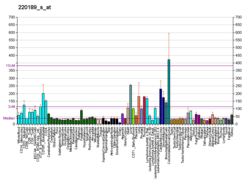MGAT4B
Alpha-1,3-mannosyl-glycoprotein 4-beta-N-acetylglucosaminyltransferase B is an enzyme that in humans is encoded by the MGAT4B gene.[5][6]
This gene encodes a key glycosyltransferase that regulates the formation of tri- and multiantennary branching structures in the Golgi apparatus. The encoded protein, in addition to the related isoenzyme A, catalyzes the transfer of N-acetylglucosamine (GlcNAc) from UDP-GlcNAc in a beta-1,4 linkage to the Man-alpha-1,3-Man-beta-1,4-GlcNAc arm of R-Man-alpha-1,6(GlcNAc-beta-1,2-Man-alpha-1,3)Man-beta-1,4-GlcNAc-beta-1,4-GlcNAc-beta-1-Asn. Therefore the protein is essential for the production of tri- and tetra-antennary sugar chains. The encoded protein may play a role in regulating the availability of serum glycoproteins, oncogenesis, and differentiation.[6] Its affinities for donors of acceptors are lower than that of MGAT4A so it is suggested that it is not the main contributor in N-glycan biosynthesis.[7]
References
- 1 2 3 ENSG00000161013 GRCh38: Ensembl release 89: ENSG00000284501, ENSG00000161013 - Ensembl, May 2017
- 1 2 3 GRCm38: Ensembl release 89: ENSMUSG00000036620 - Ensembl, May 2017
- ↑ "Human PubMed Reference:".
- ↑ "Mouse PubMed Reference:".
- ↑ Yoshida A, Minowa MT, Takamatsu S, Hara T, Ikenaga H, Takeuchi M (Jul 1999). "A novel second isoenzyme of the human UDP-N-acetylglucosamine:alpha1,3-D-mannoside beta1,4-N-acetylglucosaminyltransferase family: cDNA cloning, expression, and chromosomal assignment". Glycoconj J. 15 (12): 1115–23. doi:10.1023/A:1006951519522. PMID 10372966.
- 1 2 "Entrez Gene: MGAT4B mannosyl (alpha-1,3-)-glycoprotein beta-1,4-N-acetylglucosaminyltransferase, isozyme B".
- ↑ Q9UQ53
Further reading
- Land A, Braakman I (2001). "Folding of the human immunodeficiency virus type 1 envelope glycoprotein in the endoplasmic reticulum". Biochimie. 83 (8): 783–90. doi:10.1016/S0300-9084(01)01314-1. PMID 11530211.
- Dedera DA, Gu RL, Ratner L (1992). "Role of asparagine-linked glycosylation in human immunodeficiency virus type 1 transmembrane envelope function". Virology. 187 (1): 377–82. doi:10.1016/0042-6822(92)90331-I. PMID 1736542.
- Kalyanaraman VS, Rodriguez V, Veronese F, et al. (1990). "Characterization of the secreted, native gp120 and gp160 of the human immunodeficiency virus type 1". AIDS Res. Hum. Retroviruses. 6 (3): 371–80. doi:10.1089/aid.1990.6.371. PMID 2187500.
- Pal R, Hoke GM, Sarngadharan MG (1989). "Role of oligosaccharides in the processing and maturation of envelope glycoproteins of human immunodeficiency virus type 1". Proc. Natl. Acad. Sci. U.S.A. 86 (9): 3384–8. doi:10.1073/pnas.86.9.3384. PMC 287137. PMID 2541446.
- Dewar RL, Vasudevachari MB, Natarajan V, Salzman NP (1989). "Biosynthesis and processing of human immunodeficiency virus type 1 envelope glycoproteins: effects of monensin on glycosylation and transport". J. Virol. 63 (6): 2452–6. PMC 250699. PMID 2542563.
- Kozarsky K, Penman M, Basiripour L, et al. (1989). "Glycosylation and processing of the human immunodeficiency virus type 1 envelope protein". J. Acquir. Immune Defic. Syndr. 2 (2): 163–9. PMID 2649653.
- Robinson WE, Montefiori DC, Mitchell WM (1988). "Evidence that mannosyl residues are involved in human immunodeficiency virus type 1 (HIV-1) pathogenesis". AIDS Res. Hum. Retroviruses. 3 (3): 265–82. doi:10.1089/aid.1987.3.265. PMID 2829950.
- Blough HA, Pauwels R, De Clercq E, et al. (1987). "Glycosylation inhibitors block the expression of LAV/HTLV-III (HIV) glycoproteins". Biochem. Biophys. Res. Commun. 141 (1): 33–8. doi:10.1016/S0006-291X(86)80330-8. PMID 3099781.
- Montefiori DC, Robinson WE, Mitchell WM (1988). "Role of protein N-glycosylation in pathogenesis of human immunodeficiency virus type 1". Proc. Natl. Acad. Sci. U.S.A. 85 (23): 9248–52. doi:10.1073/pnas.85.23.9248. PMC 282716. PMID 3264072.
- Fenouillet E, Jones I, Powell B, et al. (1993). "Functional role of the glycan cluster of the human immunodeficiency virus type 1 transmembrane glycoprotein (gp41) ectodomain". J. Virol. 67 (1): 150–60. PMC 237347. PMID 8093218.
- Maruyama K, Sugano S (1994). "Oligo-capping: a simple method to replace the cap structure of eukaryotic mRNAs with oligoribonucleotides". Gene. 138 (1–2): 171–4. doi:10.1016/0378-1119(94)90802-8. PMID 8125298.
- Bolmstedt A, Sjölander S, Hansen JE, et al. (1996). "Influence of N-linked glycans in V4-V5 region of human immunodeficiency virus type 1 glycoprotein gp160 on induction of a virus-neutralizing humoral response". J. Acquir. Immune Defic. Syndr. Hum. Retrovirol. 12 (3): 213–20. doi:10.1097/00042560-199607000-00001. PMID 8673525.
- Papandreou MJ, Fenouillet E (1997). "Effect of various glycosidase treatments on the resistance of the HIV-1 envelope to degradation". FEBS Lett. 406 (1–2): 191–5. doi:10.1016/S0014-5793(97)00273-1. PMID 9109416.
- Suzuki Y, Yoshitomo-Nakagawa K, Maruyama K, et al. (1997). "Construction and characterization of a full length-enriched and a 5'-end-enriched cDNA library". Gene. 200 (1–2): 149–56. doi:10.1016/S0378-1119(97)00411-3. PMID 9373149.
- Strausberg RL, Feingold EA, Grouse LH, et al. (2003). "Generation and initial analysis of more than 15,000 full-length human and mouse cDNA sequences". Proc. Natl. Acad. Sci. U.S.A. 99 (26): 16899–903. doi:10.1073/pnas.242603899. PMC 139241. PMID 12477932.
- Clark HF, Gurney AL, Abaya E, et al. (2003). "The secreted protein discovery initiative (SPDI), a large-scale effort to identify novel human secreted and transmembrane proteins: a bioinformatics assessment". Genome Res. 13 (10): 2265–70. doi:10.1101/gr.1293003. PMC 403697. PMID 12975309.
- Ota T, Suzuki Y, Nishikawa T, et al. (2004). "Complete sequencing and characterization of 21,243 full-length human cDNAs". Nat. Genet. 36 (1): 40–5. doi:10.1038/ng1285. PMID 14702039.
- Brandenberger R, Wei H, Zhang S, et al. (2005). "Transcriptome characterization elucidates signaling networks that control human ES cell growth and differentiation". Nat. Biotechnol. 22 (6): 707–16. doi:10.1038/nbt971. PMID 15146197.




